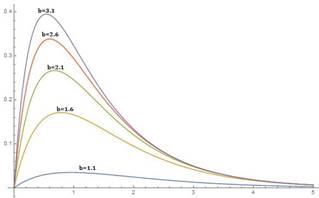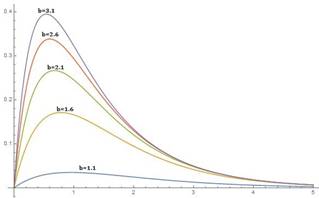
Concept explainers
To Graph:The several members of the family.
Answer to Problem 26E

Explanation of Solution
Given: The family of functions f(t)=C(e−at−e−bt) where a,b,c are the positive numbers b>a has been used to model the concentration of a drug injected into the blood-stream at a time t=0 .Graph the several members of the family. What do they have in common? For fixed values of C,a discover graphically what happens as b increases. Then use calculus to prove what you have discovered.
Given: f(t)=C(e−at−e−bt)
The graph for the function as b increases is

Differentiating
ddt(C(e−at−e−bt)=C(be−bt−ae−at)
Thus
ae−at0=be−bt0
Taking log both sides
lnae−at0=lnbe−bt0lnba=(b−a)t0t0=lnbab−a
Differentiating with respect to b
dt0db=b−ab−lnba(b−a)2−1ab<0dt0db<0
Here the function reaches at the maximum point.
Now,
f(t0)=C((ba)−ab−a−(ba)−bb−a)thendf(t0)db=(ba)−bb−aln(ba)b−a
That means it is always greater than zero as b>a so the value of the function as its maximum increases as b increases.
Chapter 4 Solutions
Single Variable Calculus: Concepts and Contexts, Enhanced Edition
- Explain the key points and reasons for the establishment of 12.3.2(integral Test)arrow_forwardUse 12.4.2 to determine whether the infinite series on the right side of equation 12.6.5, 12.6.6 and 12.6.7 converges for every real number x.arrow_forwarduse Cauchy Mean-Value Theorem to derive Corollary 12.6.2, and then derive 12.6.3arrow_forward
- Explain the focus and reasons for establishment of 12.5.1(lim(n->infinite) and sigma of k=0 to n)arrow_forwardExplain the focus and reasons for establishment of 12.5.3 about alternating series. and explain the reason why (sigma k=1 to infinite)(-1)k+1/k = 1/1 - 1/2 + 1/3 - 1/4 + .... converges.arrow_forwardExplain the key points and reasons for the establishment of 12.3.2(integral Test)arrow_forward
 Calculus: Early TranscendentalsCalculusISBN:9781285741550Author:James StewartPublisher:Cengage Learning
Calculus: Early TranscendentalsCalculusISBN:9781285741550Author:James StewartPublisher:Cengage Learning Thomas' Calculus (14th Edition)CalculusISBN:9780134438986Author:Joel R. Hass, Christopher E. Heil, Maurice D. WeirPublisher:PEARSON
Thomas' Calculus (14th Edition)CalculusISBN:9780134438986Author:Joel R. Hass, Christopher E. Heil, Maurice D. WeirPublisher:PEARSON Calculus: Early Transcendentals (3rd Edition)CalculusISBN:9780134763644Author:William L. Briggs, Lyle Cochran, Bernard Gillett, Eric SchulzPublisher:PEARSON
Calculus: Early Transcendentals (3rd Edition)CalculusISBN:9780134763644Author:William L. Briggs, Lyle Cochran, Bernard Gillett, Eric SchulzPublisher:PEARSON Calculus: Early TranscendentalsCalculusISBN:9781319050740Author:Jon Rogawski, Colin Adams, Robert FranzosaPublisher:W. H. Freeman
Calculus: Early TranscendentalsCalculusISBN:9781319050740Author:Jon Rogawski, Colin Adams, Robert FranzosaPublisher:W. H. Freeman
 Calculus: Early Transcendental FunctionsCalculusISBN:9781337552516Author:Ron Larson, Bruce H. EdwardsPublisher:Cengage Learning
Calculus: Early Transcendental FunctionsCalculusISBN:9781337552516Author:Ron Larson, Bruce H. EdwardsPublisher:Cengage Learning





